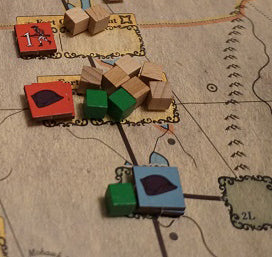
One of the things I really enjoy about John Theissen's operational ACW games (More Aggressive Attitudes, Objective Shreveport!, and Hood's Last Gamble, for those keeping score) is how difficult it can be to have a proper battle. Whenever you declare combat, your opponent usually has the option of attempting to Retreat Before Combat (RBC), with a 66% chance of success (sometimes more). With a successful roll, the enemy stack slips through your fingers. And, when the shoe is on the other foot, you slip through theirs.
Both sides generally want to do battle with the enemy, because winning battles decisively is one way in which you can score Victory Points. But Mr. Theissen's combat tables are often inconclusive and attritional, and so a battle in which the sides are roughly even is unlikely to give you a victory. As your stack gets worn down by repeated clashes, the chances of ever achieving a clear victory is diminished. And so you don't really want to launch a battle with equal odds; you want to attack when the odds are in your favor. And, of course, your opponent doesn't really want to accept battle unless the odds are roughly even. And so they RBC early and often, until at last you find the hill they're willing to die on.

There's a similar dynamic at play in my Supply Lines of the American Revolution: The Northern Theater, 1775-1777. There, a stack that's been attacked can always Refuse Battle - there's no die roll - provided there's somewhere for them to retreat to, and provided they don't mind leaving some of their supplies behind. As you'd expect from the title, attack power is tied to the number of War Supply cubes an army has and wishes to expend, but whether or not you win the battle, and whether or not the losing defender passes their morale check, depends entirely on numbers. If after the dust clears you have more units than the other side, you win. The greater the difference between the two armies, the more likely it is that the defender will fail the check and have to leave their cushy Fort or City. And so, the attacker is incentivized to throw overwhelming numbers against smaller defending stacks, and the defender is more likely to Refuse Battle unless there's some parity between the two.
Unless of course the ground the defender is standing on is one they absolutely can't afford to give up - then they've no choice but to stand and fight and cross their fingers. Or unless you've cut off all retreat possibilities. In the end, as in Mr. Theissen's designs, it all comes down to a tense game of cat-and-mouse.
As a player, I find this sort of thing absolutely thrilling and captivating. Like most wargamers, I find that there's something primal and appealing about the illusion of maneuver, and in these sorts of games, maneuver is turned up to eleven. Even though the actual resolution of combat relies heavily on numbers and mass, getting into combat in the first place is a function of maneuver: combat itself becomes a function of maneuver. I don't get that same sensation when playing a wargame that's more about making attacks up and down the line.
Though this element was present in the first Supply Lines game, it wasn't necessarily the emphasis of the game. It's undeniably there, but the system doesn't focus on it in the same way it does in Mr. Theissen's designs. That changed when I designed the second Supply Lines game, The Southern Strategy. There are far fewer units this time around, and long multi-stack supply lines become much more of a liability. Both sides are much more likely to concentrate their forces into one or two relatively small stacks that are rendered vulnerable even when the odds are equal. During the actual campaign, Nathanael Greene masterfully employed Fabian tactics to avoid battle while drawing Cornwallis farther and farther away from his supply bases. Such tactics will serve both players well.
I've even seen a game of The Southern Strategy go by without a single battle ever being fought. That's due in part to the new Siege mechanism. Briefly, if you occupy a City or Fort and the enemy occupies two adjacent Locations, your Army is Under Siege, which greatly reduces your options and requires the expenditure of a Food cube every Game Turn. Run out of Food cubes, your Army surrenders - which might even result in you losing the war and the game itself. In this way, it can become a game of pure maneuver.

2 comments
I haven’t, Scott, but I’ll give it a look. Thanks!
Tom
Tom, have you read this book? I found it interesting on this topic of seeking decisive victories (nearly always without success).
https://www.amazon.com/Age-Battles-Decisive-Breitenfeld-Waterloo/dp/0253363802
Scott Muldoon